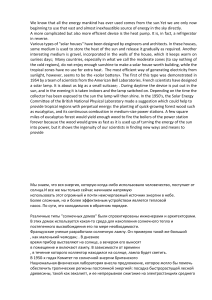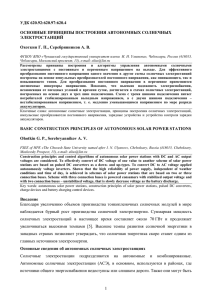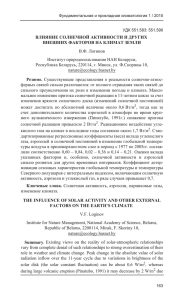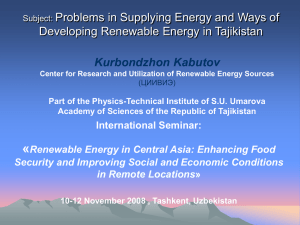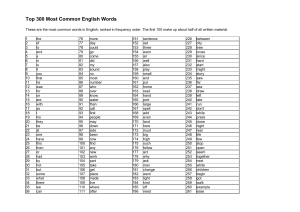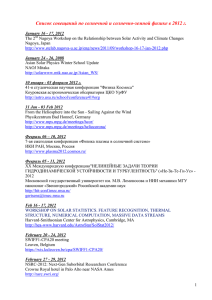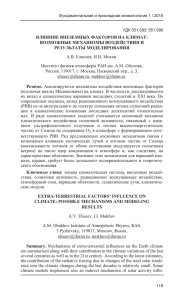
See discussions, stats, and author profiles for this publication at: https://www.researchgate.net/publication/323246768 Wind and solar power as possible energy alternatives in peripheral high mountains? Insights from the Eastern Pamirs of Tajikistan Article · January 2017 DOI: 10.21177/1998-4502-2017-9-4-343-354 CITATIONS READS 0 247 3 authors, including: Harald Zandler Cyrus Samimi University of Bayreuth University of Bayreuth 17 PUBLICATIONS 177 CITATIONS 122 PUBLICATIONS 1,565 CITATIONS SEE PROFILE SEE PROFILE Some of the authors of this publication are also working on these related projects: DRYLANDS FACING CHANGE: INTERDISCIPLINARY RESEARCH ON CLIMATE CHANGE, FOOD INSECURITY, POLITICAL INSTABILITY- COST Action CA16233 View project Summer School "Scales and data quality in social-ecological research on drylands" View project All content following this page was uploaded by Harald Zandler on 28 February 2018. The user has requested enhancement of the downloaded file. SUSTAINABLE DEVELOPMENT OF MOUNTAIN TERRITORIES WIND AND SOLAR POWER AS POSSIBLE ENERGY ALTERNATIVES IN PERIPHERAL HIGH MOUNTAINS? INSIGHTS FROM THE EASTERN PAMIRS OF TAJIKISTAN 1. Introduction Wind and solar energy are considered as key resources for rural electrification and to foster sustainability in developing countries (Sovacool et al. 2011). Peripheral mountain areas are of special interest in this regard, as they are increasingly vulnerable to energy poverty and renewable energy technologies may constitute the only feasible option for energy supply (Bhandari and Stadler 2011; Katsoulakos 2011). Furthermore, a high potential of renewable energy resources is anticipated for mountain areas (Förster et al. 2011) and hybrid wind-solar energy systems have gained popularity in increasing the efficiency of energy generation (Khare et al. 2016). As a consequence, the development of renewable energy infrastructure in mountain regions was strongly promoted in recent years (Wang and Qiu 2009; Limao et al. 2012; Fthenakis et al. 2014). However, wind and solar based rural electrification systems in developing countries may fail or may be subject to unscheduled closures after very limited operation periods (Tamir et al. 2015). An important reason for these failures is attributed to insufficient assessment of the anticipated performance of respective energy resources. Especially in mountainous areas, site specific evaluations are considered as essential to assess the feasibility of wind and solar energy (Tamir et al. 2015), and improvements in renewable energy resource evaluation are necessary in complex terrain (Angelis-Dimakis et al. 2011). Besides, adequate sizing of energy infrastructure to meet local electricity demand is crucial for the acceptance of renewable energy systems (Shyu 2013; Tamir et al. 2015). Hence, a straightforward assessment that is adapted to the specific environmental conditions, the local requirements and that considers the synergy of different energy resources is fundamental for the success of renewable energy projects (Khare et al. 2016). The Eastern Pamirs, an arid high mountain plateau in Tajikistan, the poorest country of the former Soviet Union (Breu 2006), is a region were the utilization of renewable energy resources is considered as urgent issue to enable sustainable development (Hoeck et al. 2007; Förster et al. 2011; Wiedemann et al. 2012; Kraudzun et al. 2014). Simultaneously, the pronounced aridity, the high altitude, the exposed geographical setting and the low surface roughness due to the absence of trees raise the expectation of a high potential of wind and solar energy. However, besides a rough estimation by Kraudzun (2014) and a study on the feasibility of solar photovoltaic (PV) energy generation in the province capital by Zandler et al. (accepted), there is no study that evaluates the potential synergy of wind and solar energy resources or that compares costs and anticipated energy amounts of different implementations of respective energy carriers. This study aims to fill this regional research gap and provide an example for a locally adapted evaluation of wind and solar energy resources. In addition to the regional aspect, the study evaluates the performance of renewable energy projects based on transferable methods. Hence, it provides results for sustainable development of renewable energy which applicable to other high mountain regions. 2. Study area The Eastern Pamirs, with an extent roughly synonymous to the rajon (district) Murghab (Fig. 1), is a region characterized by undulating mountain-terrain that covers an area of approximately 38,400 km² with elevations mostly between 3,500 and 5,500 Professorship of Climatology, Faculty of Biology, Chemistry and Earth Sciences, University of Bayreuth, Universitätsstrasse 30, 95447 Bayreuth, Germany 2 Bayreuth Center of Ecology and Environmental Research, BayCEER, Dr. Hans-Frisch-Straße 1-3, 95448 Bayreuth, Germany * e-mail: harald.zandler@uni-bayreuth.de 1 V.9. №4(34), 2017 г. H. Zandler*, T. Morche , 1,2 C. Samimi 1 1 УДК: 550.424 DOI: 10.21177/1998-4502-20179-4-343-354 Wind energy, solar energy and their hybrid use are frequently considered as solutions for energy provision in the periphery of developing countries. This is also true for the arid mountains of the Eastern Pamirs of Tajikistan, where a high potential of respective renewables is expected due to the geographical characteristics. However, the failure of renewable energy projects in comparable regions and the complex topography of mountains introduce the need for preceding assessments of renewable energy resources. Therefore, we analyzed the potential, cost and synergy of wind and solar energy for electricity generation in three local villages. Methodologically, measured climate data, a solar atlas, a scenario of energy requirements, current prices for energy components and literature derived calculation methods were used to allow for an integrative evaluation of potential energy projects. Centralized solar photovoltaic systems resulted in the lowest cost (US$ 3,653 - 4,798 per household), followed by decentralized photovoltaic applications, which amounted to an approximate doubling of the budget to meet minimum energy requirements for basic applications. Wind energy systems were connected to a much higher investment cost (US$ 24,453 – 74,151 per household), which may be regarded as not feasible compared to current budgets of regional energy projects. The analysis of solar radiation and wind speed showed largely similar variations over time indicating low potential for hybrid applications of these resources. We suggest that solar photovoltaic systems, in contrast to wind power, have a high potential as energy alternative in the Eastern Pamirs and comparable mountain areas. The presented method is easily applicable to other regions as a pre-assessment tool to minimize failures of renewable energy projects for sustainable development. KEYWORDS: Renewable energy; hybrid; sustainability; photovoltaics; system costs; energy potentials Article received 01.11.2017 343 УСТОЙЧИВОЕ РАЗВИТИЕ ГОРНЫХ ТЕРРИТОРИЙ Fig. 1: Map of the study area. Villages investigated are shown in black font color. Source of digital elevation model: METI and NASA (2009) meters above sea level (m.a.s.l.). The high altitude, the continental setting and the surrounding mountain ranges lead to a cold and arid climate with annual mean temperatures ranging from ‑6 to ‑1 °C and a mean precipitation between 94 and 155 mm (Tajik Hydrometeorological Service 2013). The treeless vegetation is dominated by scarce dwarf shrubs (Krascheninnikovia ceratoides, Artemisia spp.), which provide the only locally available woody biomass (Zandler et al. 2015). Permanent settlements are located in broader valleys at altitudes of around 3,600 to 4,000 m.a.s.l. and animal husbandry is the main economic activity (Kraudzun et al. 2014). The simultaneous use of dwarf shrubs as winter forage for livestock and the utilization as an important thermal energy carrier due to lacking alternative energy resources has led to increasing, partly alarming concern on the sustainable development of the region (Droux and Hoeck 2004; Breckle and Wucherer 2006; Kraudzun 2014; Kraudzun et al. 2014). Coal, which is imported over long distances, and animal manure are also used for heating purposes, but their availability is limited in the region. Although a Soviet-era hydropower plant and an electricity grid in the province capital (named Murghab identical to the district) exist, the generated energy is insufficient to lower the pressure on local thermal energy resources (Kraudzun 2014). Until today, other renewable energy sources deliver only negligible energy amounts (Hohberg et al. 2015). 3. Methods Appropriate assessment of energy systems requires data of high temporal resolution that reflects diurnal pat344 terns (Suomalainen et al. 2012), and this resolution is also necessary for evaluating the daily synergy of wind and solar energy. The basic data is provided by three automatic weather stations in Murghab (3,650 m.a.s.l.), Alichur (3,900 m.a.s.l.) and Shaymak (3,900 m.a.s.l.) were wind speed, gust speed, global radiation and temperature were recorded at a height of two meters, at a one minute measuring and a half hourly logging interval for a period of two years from 1st of January 2013 until the 31st of December 2014. Although a longer time series would be preferable, a minimum period of one year may be considered as a reasonable indication of renewable energy potentials (Angelis-Dimakis et al. 2011). Due to technical malfunctions, some wind speed measurements produced no data values during one summer in Alichur and Murghab which were not included in the analysis. The locations of the stations were selected to represent the main settlement areas: Murghab is the largest town (1515 households, Kreczi 2011), Alichur the second largest village (210 households, Hohberg et al. 2015) and Shaymak (76 households, Kreczi personal communication) characterizes the southernmost part of permanent habitation in the Eastern Pamirs. Furthermore, this setting covers different exposures to wind and various compass directions. Additionally, official climate stations exist in Murghab, Shaymak and Bulunkul, but these datasets were not used for the assessment as global radiation is not measured and other climate parameters are only available on a daily basis. However, data of these official stations may be used for the appraisal of the long Т.9. №3(33), 2017 г. SUSTAINABLE DEVELOPMENT OF MOUNTAIN TERRITORIES term representativeness of own measurements. To assess the potential of wind speed or solar radiation in providing energy when the other energy resource is at its minimum, e.g. wind energy during winter or nighttime, diagrams of the monthly and diurnal variation were compiled. 3.1 Energy requirements Electric energy is currently only minimally available for households owning small PV sets in Alichur and Shaymak. In Murghab, grid electricity is subject to strong voltage fluctuation and electricity supply is cut off several times during the day, making regular use of electric devices problematic (Kraudzun 2014). Therefore, data on electric energy consumption cannot be derived from field observations and a scenario based assessment is necessary. A central subject is the substitution of thermal energy to lower the pressure on regional dwarf shrubs. Therefore, potential energy requirements derived from Zandler et al. (accepted) are applied which consider the generation of renewable energy for the consumption of hot water, lighting and television which amounts to 2.14 kWh per day per household. The respective usage is supported by recent observations on regional utilization of energy if electricity is available (Kraudzun 2014; Mislimshoeva et al. 2014). Sizing of renewable energy systems was calculated to meet this minimum energy amount throughout the year. 3.2 Implementations of wind and solar energy infrastructure Several options of utilizing wind and solar energy are available (Angelis-Dimakis et al. 2011). Regarding solar radiation, only PV energy production is considered in this study as recurring and prolonged freezing periods occur even during summer months which impede the utilization of solar thermal applications. Two different implementations are considered using PV techniques: (a) a centralized PV plant were energy is generated, converted and stored within one large facility and distributed over an electricity grid encompassing all households, and (b) decentralized PV systems including storage devices in every household without an electricity grid. A large range of capacities is available for wind turbines. However, as the accessibility of the Eastern Pamirs is difficult and the only major road, the Pamir Highways, is mostly unpaved, very narrow and crosses unbridged streams and several passes of more than 4,000 m.a.s.l., terrestrial transportation options are very limited in the region. Therefore, only small-scale wind turbines are hypothesized to be suitable options in the near future. For this study, the Evance R9000 5 kW wind turbine with a hub height of 18 m (Evance Wind Turbines Ltd 2015) was chosen as the basic unit for electricity generation. Respective turbines include an internal inverter and deliver alternating current (AC). The implementation is considered as a centralized system with additional storage devices whereby energy is distributed using an electricity grid. 3.3 Calculation of PV energy infrastructure and generated energy amounts Available solar radiation amounts on an ideally inclined surface are derived from a regional atlas of solar radiation developed by Zandler et al. (accepted) with a monthly mean error in relation to the validation stations of 7 %. For the centralized PV plants, mean monthly solar radiation amounts were derived from suitable areas (flat terrain, avoidance of pasture areas, extent corresponding to required panel area) next to the villages. For the decentralized PV systems, averaged solar radiation quantities of the settlement area were used. The month with minimum radiation served for system sizing to meet minimum energy requirements in every month. Costs and system infrastructure adapted to various wattages of the systems, containing solar modules and inverters to deliver AC, were calculated according to a modified approach as given in (Chandel et al. 2014). System components and respective prices are summarized in Table 1. Currency exchange rates were set to the mean value of 2014 (Oanda 2015). 3.4 Calculation of wind energy infrastructure and generated energy amounts Turbine specific power curves determine wind energy generation at a given wind speed. The power curve of the Components of different implementations for PV and wind energy generation Table 1 Component System Unit price US$ Source Module: Solarworld Sunmodule Plus Centralized / decentralized PV 331 (Europe Solarshop 2015a) SW 275 mono systems, all sites DC/AC Inverter: Fronius Agilo 100.0-3 Centralized PV systems, all sites 20,970 (Europe Solarshop 2015b) Outdoor DC/AC Inverter: SMA Sunny Boy 2.5 Decentralized PV systems, all sites 992 (Europe Solarshop 2015c) AC/DC Battery inverter: Eaton Power Centralized PV and wind energy 330,000 (Eaton 2014) Xpert Storage 2250 kW systems Murghab AC/DC Battery inverter: SMA Sunny Centralized PV and wind energy 4,304 (Europe Solarshop 2015d) Island 8.0H systems Alichur, Shaymak AC/DC Battery inverter: SMA Sunny Decentralized PV systems, all sites 3,084 (Europe Solarshop 2015e) Island 4.4M Hoppecke OPzS solar.power batteries All systems 3,733 / 35,030 (Europe Solarshop 2015f) 48V 280Ah / 4700Ah (Better Generation Group Ltd 2015) Evance R9000 5 kW wind turbine Wind energy systems 42,538 V.9. №3(33), 2017 г. 345 УСТОЙЧИВОЕ РАЗВИТИЕ ГОРНЫХ ТЕРРИТОРИЙ Evance R9000 5 kW wind turbine (Evance Wind Turbines Ltd 2015) is best described by the Richards growth function as given in Kahm et al. (2010). Generally, power curves are adapted to standard test conditions considering air density at sea level. To account for the considerably lower air densities of the high mountain plateau, the improved correction algorithm of Svenningsen (2010) was applied to fit the power curve function to site specific conditions (Fig. 2). Standard atmosphere air densities were derived from the International Civil Aviation Organization (1993). Fig. 2, Power curves of the Evance R9000 5 kW wind turbine at sea level (red) and the corrected version for an altitude of 3,900 m.a.s.l. (black) The empirical power law function (Kubik et al. 2011) was used to convert measured values to a hub height of 18 m. Altitude adapted power curve functions were then used to calculate generated power at a half hourly interval from wind speeds at the different stations. Gust speed measurements were used to consider cut-out wind speed. However, sufficiently strong winds were not measured during the reference period. Finally, generated AC power per wind turbine was averaged to monthly values. System sizing was performed based on the month with the minimum energy generation per turbine. 3.5 Calculation of energy storage The availability of both wind and solar energy resources is highly variable in time and hence, energy storage is necessary. The calculation of required batteries is based on the methodology given in Chandel et al. (2014) and a maximum battery discharge of 40 %, a battery loss of 15 %, battery autonomy of one day and a battery discharge over 10 hours were anticipated. Various sizes of Hoppecke OPzS solar.power batteries (Hoppecke Battery GmbH 2015) and inverters for battery charging were selected according to the requirements of the different implementations (Table 1). 3.6 Total system costs The costs for electricity generations and battery storage were summarized for all implementations of renewable energy systems. To consider expenses for construction, this sum was increased by 15 % as suggested by (SMA 2015). A summary of all systems and related components is shown in the appendix. 4. Results 4.1 Cost of renewable energy systems Cost assessment showed that amounts for PV energy systems were much lower than those for wind turbine based energy systems in all analyzed villages (Tab. 2). At the most favorable location, in Alichur, an implementation of wind energy generation to minimally produce required energy amounts resulted in a doubling of the price compared to the most expensive PV system. In the other villages, the necessary budget would be more than three times larger. Regarding PV systems, centralized PV systems resulted in considerably lower cost with less than half the amount of decentralized PV systems. The cheapest option, if costs per households are evaluated, was the centralized PV system in Murghab, the largest structure, with US$ 3,653. 4.2 Potentially generated energy amounts All PV systems showed an approximate doubling of generated energy in summer (July) compared to the minimum amounts in winter (December, Tab. 3). Generation of wind energy showed more heterogeneity, whereby very low energy amounts would potentially be generated in winter in Murghab and Alichur and in fall in Shaymak. Table 2 Calculated costs of different implementations for PV and wind energy systems Total cost centralized PV systems Total cost decentralized PV systems Total cost wind energy systems Cost per household centralized PV systems Cost per household decentralized PV systems Cost per household wind energy systems 346 Murghab Alichur Shaymak US$ 5,534,230 US$ 15,910,734 US$ 51,386,419 US$ 1,006,046 US$ 2,205,448 US$ 5,135,177 US$ 364,641 US$ 769,233 US$ 5,635,507 US$ 3,653 US$ 4,791 US$ 4,798 US$ 10,502 US$ 10,502 $10,121 US$ 33,918 US$ 24,453 US$ 74,151 Т.9. №3(33), 2017 г. SUSTAINABLE DEVELOPMENT OF MOUNTAIN TERRITORIES Table 3 Monthly values of generated energy amounts considering losses of different renewable energy implementations in kWh per day per household Mоnth January February March April May June July August September October November December Centralized PV systems Decentralized PV systems Murghab Alichur Shaymak Murghab Alichur Shaymak Murghab Alichur Shaymak 2.70 3.05 3.91 4.03 4.32 4.97 5.44 4.04 4.53 4.00 2.98 2.25 2.55 2.86 3.62 3.71 3.96 4.53 4.95 3.72 4.15 3.71 2.81 2.25 2.40 2.68 3.39 3.45 3.69 4.24 4.62 3.46 3.89 3.45 2.63 2.26 3.02 3.42 4.41 4.55 4.88 5.63 6.15 4.57 5.12 4.50 3.34 2.51 3.26 3.65 4.62 4.73 5.05 5.78 6.32 4.74 5.30 4.73 3.58 2.87 2.40 2.68 3.39 3.46 3.67 4.19 4.57 3.46 3.89 3.45 2.63 2.26 3.41 6.78 5.84 10.56 7.76 9.72 8.32 5.45 6.22 4.80 5.36 2.78 2.78 8.17 7.74 12.72 13.86 15.30 14.32 9.48 10.23 8.04 7.02 3.82 6.97 8.23 6.42 6.67 8.35 5.89 4.99 4.44 3.27 2.80 5.20 5.05 Maximum values were calculated for spring and summer. A large difference between maximum and minimum wind generated energy amounts is visible at all stations with up to a fivefold increase in Alichur. 4.3 Synergy of wind and solar energy resources The yearly variations of wind speed and solar radiation resulted in a largely simultaneous pattern in Murghab and Alichur with maxima in summer and minima in winter months (Fig 3a and 3b). In Shaymak, radiation maxima were visible for summer months compared to wind speed maxima in spring and wind speed minima during fall. Regarding the diurnal pattern, radiation values resulted in typical Gaussian shaped curves with maxima at noon. Wind speed maxima were visible in the afternoon yours. Minimum values were recorded during nighttime. 5. Discussion 5.1 Comparison of wind and solar energy systems To our knowledge, this is the first study that compares the costs of renewable energy systems for independently generating basic energy amounts in Tajikistan. We showed that in the Eastern Pamirs, PV energy systems allow for energy provision at a considerably lower cost than expected from wind energy applications. This is in agreement with results of Sinha and Chandel (2015) stating a higher potential for PV systems compared to wind power generation in the Himalayan region. However, different results were reported from other developing regions where the assessment resulted in lower cost of wind power than PV energy (Schmidt et al. 2012). One reason for the low suitability of wind energy in this study may be the influence of lower air density on wind power generation in this extreme altitude. This amounted to an approximately 30 % lower energy generation with the power curve adapted to station altitude (3,650 – 3,900 m.a.s.l.) compared to the potential energy generation under standard air density conditions at sea level. Another reason is the very low amount of wind energy V.9. №3(33), 2017 г. Wind energy systems available in winter or fall that requires a large number of wind turbines to generate minimum energy amounts. As also stated by Tamir et al. (2015), these results emphasize the need for detailed resource assessment for renewable energy projects. Regarding financial aspects from another perspective, calculated costs of centralized PV systems may be considered as a reasonable investment with US$ 5,534,230 in Murghab as a running energy project in the same village, aiming in modernizing the local hydropower plant, has a higher budget of US$ 6,646,500 (AHK 2013). Similar to the results of Wang and Qiu (2009), this shows that solar energy has considerable potential in arid high mountain regions and may be one of the most important renewable energy resources. However, using the cost of this project as a baseline would also mark wind energy systems and decentralized PV systems as not feasible alternatives in the province capital and would only allow for smaller realizations of these systems. 5.2 Energetic synergy The study showed that the potential of wind and solar resources to alternatively produce energy when the other source is at its minimum is very low in the research area. Both seasonal and daily variations are similar. Hence, power generation in winter and nighttime is problematic. This is in contrast to results obtained in Tibet, where wind energy seems to be available during winter and nighttime (Wang and Qiu 2009). However, from a climatological point of view, the measured variation of wind energy seems reasonable. Generally, solar irradiation is lower and there is less energy available in winter. This reduces heating contrasts and hence, diurnal wind systems (Chow et al. 2013). Furthermore, a stable inversion with low winds persists in winter which is indicated by our temperature measurements in different altitudes. The higher wind speeds measured during afternoon hours may be explained by the break-in of plain 347 УСТОЙЧИВОЕ РАЗВИТИЕ ГОРНЫХ ТЕРРИТОРИЙ Fig. 3. Hourly (lines) and monthly (columns) averages of diurnal global radiation (grey color) and mean wind speed at hub height (black color) in (a) Alichur, (b) Murghab, and (c) Shaymak 348 Т.9. №3(33), 2017 г. SUSTAINABLE DEVELOPMENT OF MOUNTAIN TERRITORIES to plateau winds usually occurring in the late afternoon as explained in Chow et al. (2013). During nighttime, surrounding mountains prevent the drainage of cold air from the plateau and produce strong and deep inversions with low wind speeds (Chow et al. 2013). The variation of solar radiation is easily explained by the astronomical cycle of the sun with slight adaptations due to overcast conditions especially during August. A realization of sequential hybrid wind-solar energy systems, as outlined in Khare et al. (2016), may therefore not be feasible in mountain regions with a comparable setting to the Eastern Pamirs. Regarding energy amounts, the variation of solar energy would allow for increased utilization of appliances in summer, such as the additional operation of an electric cooker per household for approximately two hours. 5.3 Methodological feasibility The presented approach is a straightforward, relatively simple method easily applicable to comparable regions. If no regional solar radiation atlas based on measurements is available, other sources may be used as a substitute. A potential alternative in Europe, Africa and Asia are values derived from the Photovoltaic Geographical Information System (PVGIS, EU JRC 2016). In this study however, such an approach would result in a slightly increased validation error of available radiation from 7 % to 12 % at the respective stations. An important issue of evaluating potentials of renewable energy resources is the representativeness of the basic data used for the assessment (Angelis-Dimakis et al. 2011). As the applied climatic dataset is relatively short, this subject needs further considerations. A comparison of monthly wind values of own measurements and long term averages (15 year means) available from official climate stations in Murghab and Shaymak shows that wind directions and seasonality are largely identical. Wind speed values extrapolated to 18 m height show root mean squared differences of only 0.6 m/s. Regarding solar radiation, there are no measurements available for a comparison. However, using precipitation which is correlated to overcast conditions as a proxy, available data (Tajik Hydrometeorological Service 2013; TRMM 2014) shows that the reference period applied in this study is representative of the long term average. Therefore, the climatic data of this study may be considered as representative of the long term average conditions in the region. Besides, a number of simplifications were required for the assessment as some issues were out of scope of this study. Maintenance of renewable energy systems is an important cost factor as well, but similar to the outcome of project calculations in this study, wind energy systems are also connected to higher maintenance efforts (Sinha and Chandel 2015). Finally, costs for electricity grid construction, which are also important for the evaluation of energy projects, were not considered in this study as one village is already equipped with a grid and cost assessment is largely dependent on site specific conditions which may impede regional or supra-regional comparisons. However, this relativizes the higher cost of decentralized PV systems. 6. Conclusion This study showed that solar photovoltaic systems are important alternative energy resources in the arid high mountain area of the Eastern Pamirs. Centralized systems resulted in lower total cost in comparison to decentralized systems and the resulting budged is regarded as feasible in relation to regional energy project investments. Wind power, on the contrary, showed considerably lower performance in generating energy due to the low air density and the specific topographical setting. Wind speed and solar radiation resulted in a largely similar pattern with no complementary effects indicating low potential for hybrid systems. The presented method, offering a locally adapted resource assessment, is easily applicable in peripheral mountain regions to initially evaluate the feasibility of renewable energy projects. This is a prerequisite to prevent failures of new technology installations for sustainable development. Appendix Table A1 System overview System Modules Murghab centralized PV 5,309 Solarworld modules Alichur centralized PV 657 Solarworld modules Shaymak centralized PV 226 Solarworld modules Decentralized PV, all sites Wind energy Murghab 4 Solarworld modules (Shaymak 3) 988 Evance R9000 5kW wind turbines DC/AC inverters 19 DC/AC Fronius inverters 3 DC/AC Fronius inverters 1 DC/AC Fronius inverters 1 SMA Sunny Boy 2.5 inverter Batteries Battery inverters 57 Hoppecke 4700Ah 2 Eaton battery inverters batteries 8 Hoppecke 4700Ah 73 Sunny Island 8.0H batteries battery inverters 4 Hoppecke 4700Ah 27 Sunny Island 8.0H batteries battery inverters 1 Hoppecke 280Ah 1 Sunny Island 4.4M battery battery inverter 57 Hoppecke 4700Ah 2 Eaton battery inverters batteries Wind energy Alichur 91 Evance R9000 5kW wind turbines 8 Hoppecke 4700Ah batteries 73 Sunny Island 8.0H battery inverters Wind energy Shaymak 110 Evance R9000 5kW wind turbines 3 Hoppecke 4700Ah batteries 27 Sunny Island 8.0H battery inverters V.9. №3(33), 2017 г. 349 УСТОЙЧИВОЕ РАЗВИТИЕ ГОРНЫХ ТЕРРИТОРИЙ GRATITUDE: We would like to thank the Volkswagen Foundation for funding the research project Pamir II (awarded to Cyrus Samimi) that enabled our research activities. Sincere thanks also go to the GIZ Khorog and local contacts for their contributions to the establishment of our climate stations. REFERENCES: 1. AHK. Delegation of the German economy for Central Asia News. KfW financing modernization of hydro-power plant in the Pamirs with 5 million euros. [in German]. http:// zentralasien.ahk.de/news/einzelansicht-nachrichten/artikel/kfwfinanziert-modernisierung-von-wasserkraftwerk-im-pamir-fuer5-mio-euro/?cHash=da9bf6df826d7cc83d89fd24ca34d009; accessed on 18 November 2015. 2013. 2. Angelis-Dimakis A, Biberacher M, Dominguez J, Fiorese G, Gadocha S, Gnansounou E, et al. Methods and tools to evaluate the availability of renewable energy sources. Renewable and Sustainable Energy Reviews. 2011 Feb;15(2):1182–200. 3. Better Generation Group Ltd. Evance Iskra R9000 Wind Turbine. http://www.bettergeneration.co.uk/wind-turbine-reviews/evance-iskra-r9000-wind-turbine.html; accessed on 24 March 2015. 2015. 4. Bhandari R, Stadler I. Electrification using solar photovoltaic systems in Nepal. Applied Energy. 2011 Feb;88(2):458–65. 5. Breckle S-W, Wucherer W. Vegetation of the Pamir (Tajikistan): Land Use and Desertification Problems. In E. Spehn, M. Liberman, and C. Körner (eds.), Land Use Change and Mountain Biodiversity. Boca Raton, FL. 2006 [cited 2015 Mar 5]; Available from: http://www.researchgate.net/profile/S_ Breckle/publication/261596540_Vegetation_of_the_Pamir_ (Tajikistan)_Land_Use_and_Desertification_Problems_1/ links/00b7d534c3f3d44e7e000000.pdf 6. Breu T. Sustainable Land Management in the Tajik Pamirs: The Role of Knowledge for Sustainable Development. Berne: NCCR North-South / Centre for Development and Environment (CDE); 2006. 7. Chandel M, Agrawal GD, Mathur S, Mathur A. Technoeconomic analysis of solar photovoltaic power plant for garment zone of Jaipur city. Case Studies in Thermal Engineering. 2014 Mar;2:1–7. 8. Chow FK, De Wekker SFJ, Snyder BJ. Mountain Weather Research and Forecasting. Dordrecht: Springer Netherlands; 2013. 9. Droux R, Hoeck T. Energy for Gorno Badakhshan! Hydropower and Firewood Cultivation. Analysis of the Energy Situation in the Tajik Pamirs and Its Consequences for Land Use and Resource Management. Joint Diploma Thesis. Centre for Development and Environment (CDE), University of Berne, Switzerland.; 2004. 10. Eaton. Eaton Power Xpert Storage 2250 kW bidirectional inverter data sheet. http://www.eaton.com/ecm/groups/ public/@pub/@electrical/documents/content/pa08303002e.pdf; accessed on 12 June 2015. 2014. 11. EU JRC. Photovoltaic Geographical Information System - PVGIS. http://re.jrc.ec.europa.eu/pvgis/index.htm; accessed on 11 March 2016. 2016. 12. Europe Solarshop. SolarWorld 275 Mono price quote. http://www.europe-solarshop.com/solar-panels/solarworld-275. 350 html; accessed on 15 December 2015. 2015a. 13. Europe Solarshop. Fronius Agilo 100.0-3 Outdoor price quote. http://www.europe-solarshop.com/inverters/froniusagilo-100-0-3-outdoor.html; accessed on 15 December 2015. 2015b. 14. Europe Solarshop. SMA Sunny Boy 2.5 price quote. http://www.europe-solarshop.com/sma/sunny-boy/sma-sunnyboy-2-5.html; accessed on 15 December 2015. 2015c. 15. Europe Solarshop. SMA Sunny Island 8.0H price quote. http://www.europe-solarshop.com/inverters/sma-sunny-island8-0h.html; accessed on 15 December 2015. 2015d. 16. Europe Solarshop. SMA Sunny Island 4.4M price quote. http://www.europe-solarshop.com/inverters/sma-sunny-island4-4m.html; accessed on 15 December 2015. 2015e. 17. Europe Solarshop. Battery Hoppecke 26 OPzS solar.power 4700 / 48V price quote. http://www.europe-solarshop.com/batteries/battery-hoppecke-26-opzs-solar-power4700-48v.html; accessed on 14 December 2015. 2015f. 18. Evance Wind Turbines Ltd. Evance R9000 specifications. http://www.swtfieldlab.ugent.be/wp-content/uploads/2012/10/Evance_R9000_Specs.pdf; accessed on 14 December 2015. 2015. 19. Förster H, Pachova NI, Renaud FG. Energy and Land Use in the Pamir-Alai Mountains: Examples From Five Socialecological Regions. Mountain Research and Development. 2011 Nov;31(4):305–14. 20. Fthenakis V, Atia AA, Perez M, Florenzano A, Grageda M, Lofat M, et al. Prospects for photovoltaics in sunny and arid regions: A solar grand plan for Chile-Part I-investigation of PV and wind penetration. Photovoltaic Specialist Conference (PVSC), 2014 IEEE 40th [Internet]. IEEE; 2014 [cited 2015 Mar 11]. p. 1424–1429. Available from: http://ieeexplore.ieee. org/xpls/abs_all.jsp?arnumber=6925184 21. Hoeck T, Droux R, Breu T, Hurni H, Maselli D. Rural energy consumption and land degradation in a post-Soviet setting–an example from the west Pamir mountains in Tajikistan. Energy for Sustainable Development. 2007;11(1):48–57. 22. Hohberg G, Kreczi F, Zandler H. High mountain societies and limited local resources - livelihoods and energy utilization in the Eastern Pamirs, Tajikistan. Erdkunde. 2015 Sep 30;69(3):233–46. 23. Hoppecke Battery GmbH. Battery Hoppecke OPzS solar.power datasheet. http://www.europe-solarshop.com/downloadfiles/hoppecke-batteries/OPzS_solar.power_en0213.pdf; accessed on 14 December 2015. 2015. 24. International Civil Aviation Organization. Manual of the ICAO Standard Atmosphere - extended to 80 kilometers (262 500 feet). Third Edition. Montreal, Quebec. Canada; 1993. 25. Kahm M, Hasenbrink G, Lichtenberg-Fraté H, Ludwig J, Kschischo M, others. grofit: fitting biological growth curves with R. Journal of Statistical Software. 2010;33(7):1–21. Т.9. №3(33), 2017 г. SUSTAINABLE DEVELOPMENT OF MOUNTAIN TERRITORIES 26. Katsoulakos N. Combating Energy Poverty in Mountainous Areas Through Energy-saving Interventions: Insights From Metsovo, Greece. Mountain Research and Development. 2011 Nov;31(4):284–92. 27. Khare V, Nema S, Baredar P. Solar–wind hybrid renewable energy system: A review. Renewable and Sustainable Energy Reviews. 2016 May;58:23–33. 28. Kraudzun T. Bottom-up and top-down dynamics of the energy transformation in the Eastern Pamirs of Tajikistan’s Gorno Badakhshan region. Central Asian Survey. 2014 Oct 2;33(4):550–65. 29. Kraudzun T, Vanselow KA, Samimi C. Realities and myths of the Teresken Syndrome – An evaluation of the exploitation of dwarf shrub resources in the Eastern Pamirs of Tajikistan. Journal of Environmental Management. 2014 Jan;132:49–59. 30. Kreczi F. Preliminary data of 2013 energy consumption survey in the Eastern Pamirs of Tajikistan. Berlin, Germany: Freie Universität Berlin. Personal communication. 31. Kreczi F. Vulnerabilities in the Eastern Pamirs. Berlin Geographical Papers [Internet]. 2011 [cited 2015 Mar 11];39. Available from: http://edocs.fu-berlin.de/docs/servlets/ MCRFileNodeServlet/FUDOCS_derivate_000000002030/ BGP39-Vulnerabilities_in_the_Pamirs.pdf?hosts=local 32. Kubik ML, Coker PJ, Hunt C. Using Meteorological Wind Data to Estimate Turbine Generation Output: A Sensitivity Analysis. Linköping Electronic Conference Proceedings. Linköping, Sweden: Linköping University Electronic Press; 2011. p. 4074–81. 33. Limao W, Hongqiang L, Shengkui C. A Study of the Ecological Effects of Solar Energy Development in Tibet. Mountain Research and Development. 2012 Feb;32(1):83–91. 34. METI, NASA. ASTER Global Digital Elevation Model V002. Sioux Falls, SD. https://lpdaac.usgs.gov/dataset_discovery/aster/aster_products_table/astgtm; accessed on 07 August 2015.; 2009. 35. Mislimshoeva B, Hable R, Fezakov M, Samimi C, Abdulnazarov A, Koellner T. Factors Influencing Households’ Firewood Consumption in the Western Pamirs, Tajikistan. Mountain Research and Development. 2014 May;34(2):147–56. 36. Oanda. Historical currency exchange rates. http://www. oanda.com/lang/de/currency/historical-rates/; accessed on 15 December 2015. 2015. 37. Schmidt TS, Born R, Schneider M. Assessing the costs of photovoltaic and wind power in six developing countries. Nature Climate Change [Internet]. 2012 Apr 15 [cited 2016 Mar 1]; Available from: http://www.nature.com/doifinder/10.1038/ nclimate1490 38. Shyu C-W. End-users’ experiences with electricity supply from stand-alone mini-grid solar PV power stations in rural V.9. №3(33), 2017 г. areas of western China. Energy for Sustainable Development. 2013 Aug;17(4):391–400. 39. Sinha S, Chandel SS. Prospects of solar photovoltaic– micro-wind based hybrid power systems in western Himalayan state of Himachal Pradesh in India. Energy Conversion and Management. 2015 Nov;105:1340–51. 40. SMA. Technology Compendium 2 - Solar Stand-Alone Power and Backup Power Supply. http://files.sma.de/dl/10040/ INSELVERSOR-AEN101410.pdf; accessed on 12 June 2015. 2015. 41. Sovacool BK, D’Agostino AL, Bambawale MJ. Gers gone wired: Lessons from the Renewable Energy and Rural Electricity Access Project (REAP) in Mongolia. Energy for Sustainable Development. 2011 Mar;15(1):32–40. 42. Suomalainen K, Silva CA, Ferrão P, Connors S. Synthetic wind speed scenarios including diurnal effects: Implications for wind power dimensioning. Energy. 2012 Jan;37(1):41–50. 43. Svenningsen L. Proposal of an Improved Power Curve Correction. European Wind Energy Conference and Exhibition, Warsaw, Poland. 2010. p. 20–23. 44. Tajik Hydrometeorological Service. Climatic dataset for the Pamir Region acquired from the Tajik hydrometeorological service. Dushanbe, Tajikistan. 2013. 45. Tamir K, Urmee T, Pryor T. Issues of small scale renewable energy systems installed in rural Soum centres in Mongolia. Energy for Sustainable Development. 2015 Aug;27:1–9. 46. TRMM. Tropical Rainfall Measuring Mission Project and Other Sources Monthly Rainfall Product (TRMM Product 3B43 v7), :Goddard Space Flight Center Distributed Active Archive Center (GSFC DAAC). http://disc.gsfc.nasa.gov/datacollection/TRMM_3B43_V7.shtml; accessed on 06 July 2015. 2014. 47. Wang Q, Qiu H-N. Situation and outlook of solar energy utilization in Tibet, China. Renewable and Sustainable Energy Reviews. 2009 Oct;13(8):2181–6. 48. Wiedemann C, Salzmann S, Mirshakarov I, Volkmer H. Thermal Insulation in High Mountainous Regions: A Case Study of Ecological and Socioeconomic Impacts in the Eastern Pamirs, Tajikistan. Mountain Research and Development. 2012 Aug;32(3):294–303. 49. Zandler H, Brenning A, Samimi C. Potential of SpaceBorne Hyperspectral Data for Biomass Quantification in an Arid Environment: Advantages and Limitations. Remote Sensing. 2015 Apr 15;7(4):4565–80. 50. Zandler H, Mislimshoeva B, Samimi C. Solar Energy on the “Roof of the World”: Using Scenarios to Project the Potential for and Benefits of Photovoltaic Energy Production. Mountain Research and Development. accepted: 2016 Apr; 351 УСТОЙЧИВОЕ РАЗВИТИЕ ГОРНЫХ ТЕРРИТОРИЙ СВЕДЕНИЯ ОБ АВТОРАХ / Information about authors: Harald ZANDLER. Рrofessorship of Climatology, Faculty of Biology, Chemistry and Earth Sciences. University of Bayreuth, Bayreuth, Germany. E-mail: harald.zandler@unibayreuth.de Cyrus SAMIMI. Professorship of Climatology, Faculty of Biology, Chemistry and Earth Sciences. University of Bayreuth, Bayreuth Center of Ecology and Environmental Research, Bayreuth, Germany. Харальд ЗАНДЛЕР. Кафедра климатологии, факультет биологии, химии и наук о Земле. Байройтский университет, г. Байройт, Германия. E-mail: harald.zandler@uni-bayreuth.de Сайрус САМИМИ. Кафедра климатологии, факультет биологии, химии и наук о Земле. Байройтский университет, Байройтский центр экологических и экологических исследований, г. Байройт, Германия. Thomas MORCHE. Рrofessorship of Climatology, Faculty of Biology, Chemistry and Earth Sciences. University of Bayreuth, Bayreuth, Germany. Томас МОРХЕ. Кафедра климатологии, факультет биологии, химии и наук о Земле. Байройтский университет, г. Байройт, Германия. ВЕТРОВАЯ И СОЛНЕЧНАЯ ЭНЕРГИЯ КАК ВОЗМОЖНЫЕ ЭНЕРГЕТИЧЕСКИЕ АЛЬТЕРНАТИВЫ В ПЕРИФЕРИЙНЫХ ГОРНЫХ СТРАНАХ. АНАЛИТИЧЕСКАЯ ОЦЕНКА НА ПРИМЕРЕ ВОСТОЧНЫХ ПАМИР ТАДЖИКИСТАНА Х. Зандлер* Т. Морхе 1,2 С. Самими 1 Байройтский университет, г. Байройт, Германия 2 Байройтский центр экологических и экологических исследований, г. Байройт, Германия * e-mail: harald.zandler@uni-bayreuth.de 1 1 DOI: 10.21177/1998-4502-2017-9-4-343-354 Ветровая и солнечная энергия, а также их гибридное использование часто рассматриваются в качестве решения вопроса энергоснабжения периферийных и развивающихся стран. Это относится и к засушливым горам Восточного Памира в Таджикистане, где в силу географических особенностей вероятность потенциального использования возобновляемых источников энергии высока. Однако, высокая вероятность неудачной реализации подобных проектов в аналогичных регионах, а также сложный рельеф гор вынуждают прибегать к предварительной оценке возобновляемых источников энергии. В связи с этим мы проанализировали потенциал, стоимость и синергию ветровой и солнечной энергии для получения электричества в трех местных поселениях. Для интеграционной оценки потенциала энергетических проектов были использованы следующие методы: измерение климатических параметров, глобальный атлас солнечной энергии, возможные сценарии энергозатрат, текущие цены на комплектующие энергоустановок и научно обоснованные методы расчета. 352 Централизованная фотоэлектрическая система показала в результате наименьшую стоимость (3,653 - 4,798 долларов США за домовладение), за которой следуют децентрализованные фотоэлектрические системы, требующие приблизительно вдвое больших затрат для выполнения минимальных требований к энергоэффективности. Ветроэнергетические системы требуют гораздо более высоких инвестиционных издержек (24,453 – 74,151 доллара США за домовладение), которые могут рассматриваться как нерентабельные для современных региональных энергетических проектов. Анализ потенциала солнечного излучения и скорости ветра показал схожесть зависимости от временных колебаний, которые свидетельствуют о низком потенциале гибридного применения этих ресурсов. Мы предполагаем, что солнечные фотоэлектрические системы, в отличие от ветряных, обладают более высоким потенциалом в качестве энергетической альтернативы в Восточном Памире и аналогичных горных районах. Представленный метод легко применим к другим регионам для предвари- Т.9. №4(34), 2017 г. SUSTAINABLE DEVELOPMENT OF MOUNTAIN TERRITORIES тельной оценки, что может позволить свести к минимуму риски при реализации проектов возобновляемых источников энергии в интересах устойчивого развития. Ключевые слова: возобновляемая энергия, гибридный, устойчивость, фотоэлектрический, системные издержки, энергетические потенциалы Литература: 1. AHK. Delegation of the German economy for Central Asia News. KfW financing modernization of hydro-power plant in the Pamirs with 5 million euros (in German). URL: http://zentralasien.ahk.de/news/einzelansicht-nachrichten/ artikel/kfw-finanziert-modernisierung-von-wasserkraftwerkim-pamir-fuer-5-mio-euro/?cHash=da9bf6df826d7cc83d89fd 24ca34d009 (accessed date: 18.11.2015). 2. Angelis-Dimakis A, Biberacher M, Dominguez J, Fiorese G, Gadocha S, Gnansounou E, et al. Methods and tools to evaluate the availability of renewable energy sources. Renewable and Sustainable Energy Reviews, 2011, No.15(2), pp. 1182-1200. 3. Better Generation Group Ltd. Evance Iskra R9000 Wind Turbine. URL: http://www.bettergeneration.co.uk/wind-turbine-reviews/evance-iskra-r9000-wind-turbine.html (accessed date: 24.03.2015). 4. Bhandari R, Stadler I. Electrification using solar photovoltaic systems in Nepal. Applied Energy, 2011, No. 88(2), pp. 458–65. 5. Breckle S-W, Wucherer W. Vegetation of the Pamir (Tajikistan): Land Use and Desertification Problems. In E. Spehn, M. Liberman, and C. Körner (editors), Land Use Change and Mountain Biodiversity. Boca Raton, Florida, 2006. URL: http://www.researchgate.net/profile/S_Breckle/ publication/261596540_Vegetation_of_the_Pamir_(Tajikistan)_Land_Use_and_Desertification_Problems_1/ links/00b7d534c3f3d44e7e000000.pdf (accessed date: 05.03.2015). 6. Breu T. Sustainable Land Management in the Tajik Pamirs: The Role of Knowledge for Sustainable Development. Berne: NCCR North-South / Centre for Development and Environment (CDE), 2006. 7. Chandel M, Agrawal GD, Mathur S, Mathur A. Technoeconomic analysis of solar photovoltaic power plant for garment zone of Jaipur city. Case Studies in Thermal Engineering, 2014, No. 2, pp. 1–7. 8. Chow FK, De Wekker SFJ, Snyder BJ. Mountain Weather Research and Forecasting. Dordrecht: Springer Netherlands, 2013. 9. Droux R, Hoeck T. Energy for Gorno Badakhshan! Hydropower and Firewood Cultivation. Analysis of the Energy Situation in the Tajik Pamirs and Its Consequences for Land Use and Resource Management. Joint Diploma Thesis. Centre for Development and Environment (CDE), University of Berne, Switzerland, 2004. 10. Eaton. Eaton Power Xpert Storage 2250 kW bidirectional inverter data sheet. URL: http://www.eaton.com/ ecm/groups/public/@pub/@electrical/documents/content/ pa08303002e.pdf (accessed date: 12.06.2015). 11. EU JRC. Photovoltaic Geographical Information System - PVGIS. URL: http://re.jrc.ec.europa.eu/pvgis/index.htm (accessed date: 11.03.2016). 12. Europe Solarshop. Solar World 275 Mono price V.9. №4(34), 2017 г. quote. URL: http://www.europe-solarshop.com/solar-panels/ solarworld-275.html (accessed date: 15.12.2015). 13. Europe Solarshop. Fronius Agilo 100.0-3 Outdoor price quote. URL: http://www.europe-solarshop.com/inverters/fronius-agilo-100-0-3-outdoor.html (accessed date: 15.12.2015). 14. Europe Solarshop. SMA Sunny Boy 2.5 price quote. URL: http://www.europe-solarshop.com/sma/sunny-boy/smasunny-boy-2-5.html (accessed date: 15.12.2015). 15. Europe Solarshop. SMA Sunny Island 8.0H price quote. URL: http://www.europe-solarshop.com/inverters/smasunny-island-8-0h.html (accessed date: 15.12.2015). 16. Europe Solarshop. SMA Sunny Island 4.4M price quote. URL: http://www.europe-solarshop.com/inverters/smasunny-island-4-4m.html (accessed date: 15.12.2015). 17. Europe Solarshop. Battery Hoppecke 26 OPzS solar. power 4700 / 48V price quote. URL: http://www.europe-solarshop.com/batteries/battery-hoppecke-26-opzs-solar-power4700-48v.html (accessed date: 14.12.2015). 18. Evance Wind Turbines Ltd. Evance R9000 specifications. URL: http://www.swtfieldlab.ugent.be/wp‑content/ uploads/2012/10/Evance_R9000_Specs.pdf (accessed date: 14.12.2015). 19. Förster H, Pachova NI, Renaud FG. Energy and Land Use in the Pamir-Alai Mountains: Examples From Five Social-ecological Regions. Mountain Research and Development, 2011, No. 31(4), pp. 305-14. 20. Fthenakis V., Atia A.A., Perez M., Florenzano A., Grageda M., Lofat M., et al. Prospects for photovoltaics in sunny and arid regions: A solar grand plan for Chile-Part Iinvestigation of PV and wind penetration. Photovoltaic Specialist Conference (PVSC), IEEE 40th, 2014, pp.1424–1429. URL: http://ieeexplore.ieee.org/xpls/abs_all. jsp?arnumber=6925184 (accessed date: 11.03.2015). 21. Hoeck T., Droux R., Breu T., Hurni H., Maselli D. Rural energy consumption and land degradation in a post-Soviet setting–an example from the west Pamir mountains in Tajikistan. Energy for Sustainable Development, 2007, No.11(1), pp. 48-57. 22. Hohberg G., Kreczi F., Zandler H. High mountain societies and limited local resources - livelihoods and energy utilization in the Eastern Pamirs, Tajikistan. Erdkunde, 2015, No. 69(3), pp. 233–246. 23. Hoppecke Battery GmbH. Battery Hoppecke OPzS solar power datasheet. URL: http://www.europe-solarshop. com/downloadfiles/hoppecke-batteries/OPzS_solar.power_ en0213.pdf (accessed date: 14.12.2015). 24. International Civil Aviation Organization. Manual of the ICAO Standard Atmosphere - extended to 80 kilometers (262 500 feet). Third Edition. Montreal, Quebec, Canada, 1993. 25. Kahm M., Hasenbrink G., Lichtenberg-Fraté H., Ludwig J., Kschischo M., etc. Grofit: fitting biological growth curves with R. Journal of Statistical Software, 2010, No. 33(7), pp. 1-21. 26. Katsoulakos N. Combating Energy Poverty in Mountainous Areas Through Energy-saving Interventions: Insights From Metsovo, Greece. Mountain Research and Development, 2011, No. 31(4), pp. 284–292. 27. Khare V., Nema S., Baredar P. Solar–wind hybrid re- 353 УСТОЙЧИВОЕ РАЗВИТИЕ ГОРНЫХ ТЕРРИТОРИЙ newable energy system: a review. Renewable and Sustainable Energy Reviews, 2016, No. 58, 23–33. 28. Kraudzun T. Bottom-up and top-down dynamics of the energy transformation in the Eastern Pamirs of Tajikistan’s Gorno Badakhshan region. Central Asian Survey, 2014, No. 33(4), pp. 550–565. 29. Kraudzun T., Vanselow K.A., Samimi C. Realities and myths of the Teresken Syndrome – An evaluation of the exploitation of dwarf shrub resources in the Eastern Pamirs of Tajikistan. Journal of Environmental Management, 2014, No. 132, 49–59. 30. Kreczi F. Preliminary data of 2013 energy consumption survey in the Eastern Pamirs of Tajikistan. Berlin, Germany: Freie Universität Berlin. Personal communication. 31. Kreczi F. Vulnerabilities in the Eastern Pamirs. Berlin Geographical Papers, 2011. URL: http://edocs.fu‑berlin. de/docs/servlets/MCRFileNodeServlet/FUDOCS_derivate_000000002030/BGP39-Vulnerabilities_in_the_Pamirs. pdf?hosts=local (accessed date: 11.03.2015). 32. Kubik M.L., Coker P.J., Hunt C. Using Meteorological Wind Data to Estimate Turbine Generation Output: A Sensitivity Analysis. Linköping Electronic Conference Proceedings. Linköping, Sweden: Linköping University Electronic Press, 2011, pp. 4074–4081. 33. Limao W., Hongqiang L., Shengkui C. A Study of the Ecological Effects of Solar Energy Development in Tibet. Mountain Research and Development, 2012, No. 32(1), pp. 83–91. 34. METI, NASA. ASTER Global Digital Elevation Model V002. Sioux Falls, SD. URL: https://lpdaac.usgs.gov/dataset_discovery/aster/aster_products_table/astgtm (accessed date: 07.08.2015). 35. Mislimshoeva B., Hable R., Fezakov M., Samimi C., Abdulnazarov A., Koellner T. Factors Influencing Households’ Firewood Consumption in the Western Pamirs, Tajikistan. Mountain Research and Development, 2014, No. 34(2), pp. 147–156. 36. Oanda. Historical currency exchange rates. URL: http://www.oanda.com/lang/de/currency/historicalrates/ (accessed date: 15.12.2015). 37. Schmidt T.S., Born R., Schneider M. Assessing the costs of photovoltaic and wind power in six developing countries. Nature Climate Change. URL: http://www.nature.com/ doifinder/10.1038/nclimate1490 (accessed date: 01.03.2016). 38. Shyu C-W. End-users’ experiences with electricity supply from stand-alone mini-grid solar PV power stations in rural areas of western China. Energy for Sustainable Development, 2013, No. 17(4), pp. 391–400. 39. Sinha S., Chandel S.S. Prospects of solar photovoltaic– micro-wind based hybrid power systems in western Himalayan state of Himachal Pradesh in India. Energy Conversion and Management, 2015, No.105, pp. 1340–1351. 40. SMA. Technology Compendium 2 – Solar Stand-Alone Power and Backup Power Supply. URL: http://files.sma.de/ dl/10040/INSELVERSOR-AEN101410.pdf (accessed date: 12.06.2015). 41. Sovacool B.K., D’Agostino A.L., Bambawale M.J. Gers gone wired: Lessons from the Renewable Energy and Rural Electricity Access Project (REAP) in Mongolia. Energy for Sustainable Development, 2011, No.15(1), pp. 32–40. 354 42. Suomalainen K., Silva C.A., Ferrão P., Connors S. Synthetic wind speed scenarios including diurnal effects: Implications for wind power dimensioning. Energy, 2012, No. 37(1), pp. 41–50. 43. Svenningsen L. Proposal of an Improved Power Curve Correction. European Wind Energy Conference and Exhibition, Warsaw, Poland, 2010, pp. 20-23. 44. Tajik Hydrometeorological Service. Climatic dataset for the Pamir Region acquired from the Tajik hydrometeorological service. Dushanbe, Tajikistan, 2013. 45. Tamir K., Urmee T., Pryor T. Issues of small scale renewable energy systems installed in rural Soum centres in Mongolia. Energy for Sustainable Development, 2015, No. 27, pp. 1–9. 46. TRMM. Tropical Rainfall Measuring Mission Project and Other Sources Monthly Rainfall Product (TRMM Product 3B43 v7), Goddard Space Flight Center Distributed Active Archive Center (GSFC DAAC). URL: http://disc.gsfc.nasa. gov/datacollection/TRMM_3B43_V7.shtml (accessed date: 06.07.2015). 47. Wang Q, Qiu H-N. Situation and outlook of solar energy utilization in Tibet, China. Renewable and Sustainable Energy Reviews, 2009, No. 13(8), pp. 2181-2186. 48. Wiedemann C., Salzmann S., Mirshakarov I., Volkmer H. Thermal Insulation in High Mountainous Regions: A Case Study of Ecological and Socioeconomic Impacts in the Eastern Pamirs, Tajikistan. Mountain Research and Development, 2012, No. 32(3), pp. 294–303. 49. Zandler H., Brenning A., Samimi C. Potential of Space-Borne Hyperspectral Data for Biomass Quantification in an Arid Environment: Advantages and Limitations. Remote Sensing, 2015, No. 7(4), pp. 4565-4580. 50. Zandler H., Mislimshoeva B., Samimi C. Solar Energy on the “Roof of the World”: Using Scenarios to Project the Potential for and Benefits of Photovoltaic Energy Production. Mountain Research and Development, 2016. Статья поступила в редакцию 01.11.2017 Т.9. №4(34), 2017 г. УСТОЙЧИВОЕ РАЗВИТИЕ ГОРНЫХ ТЕРРИТОРИЙ 452 View publication stats Т.9. №4(34), 2017 г.
